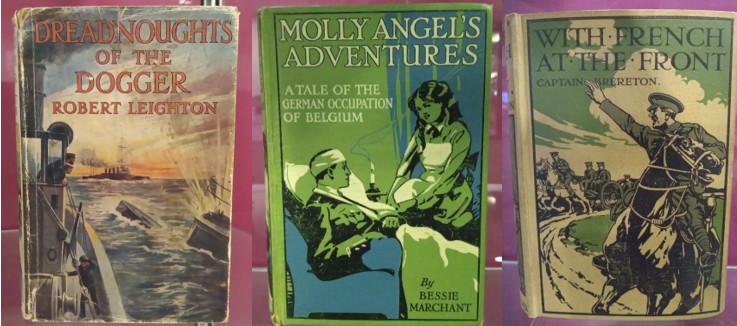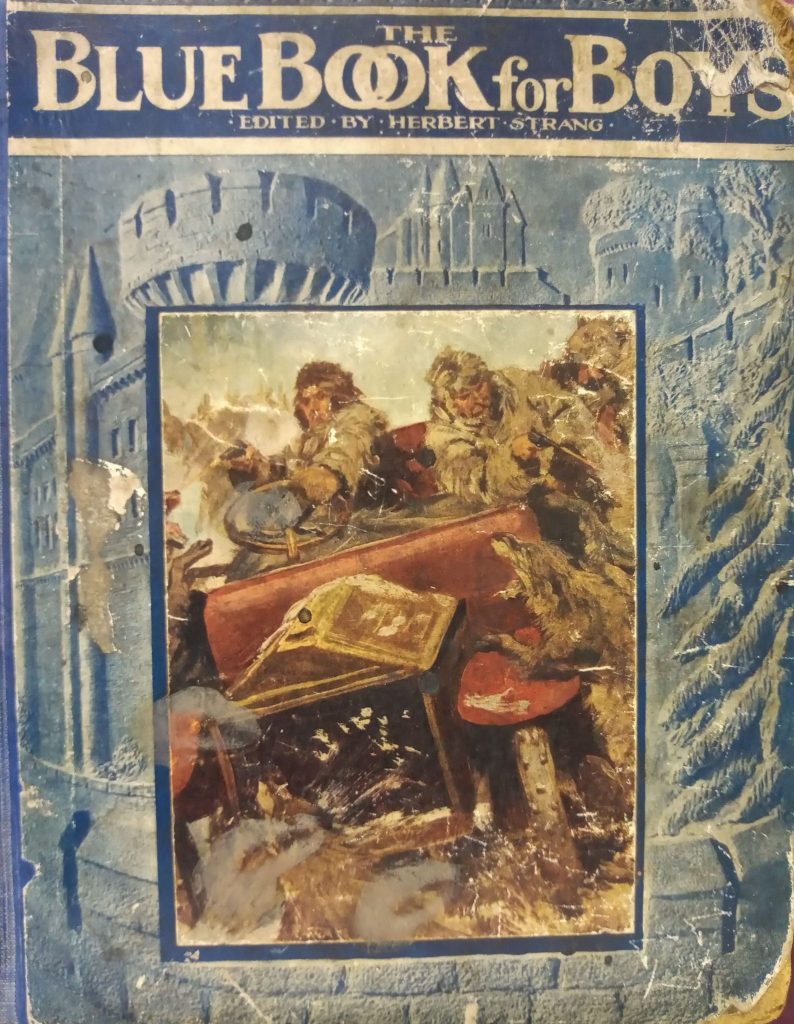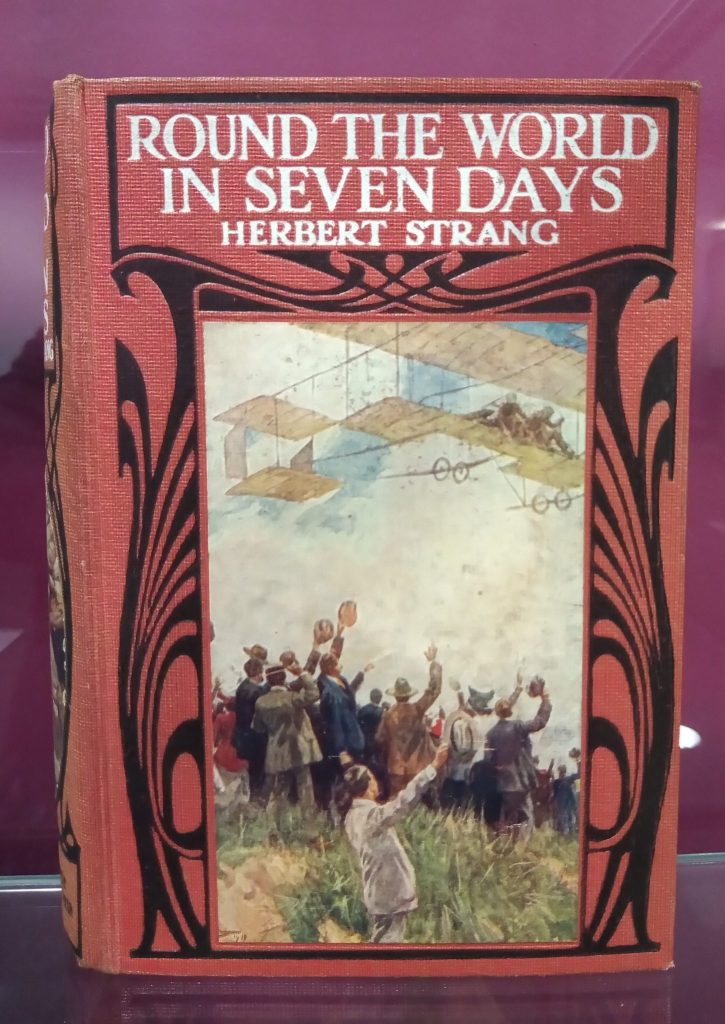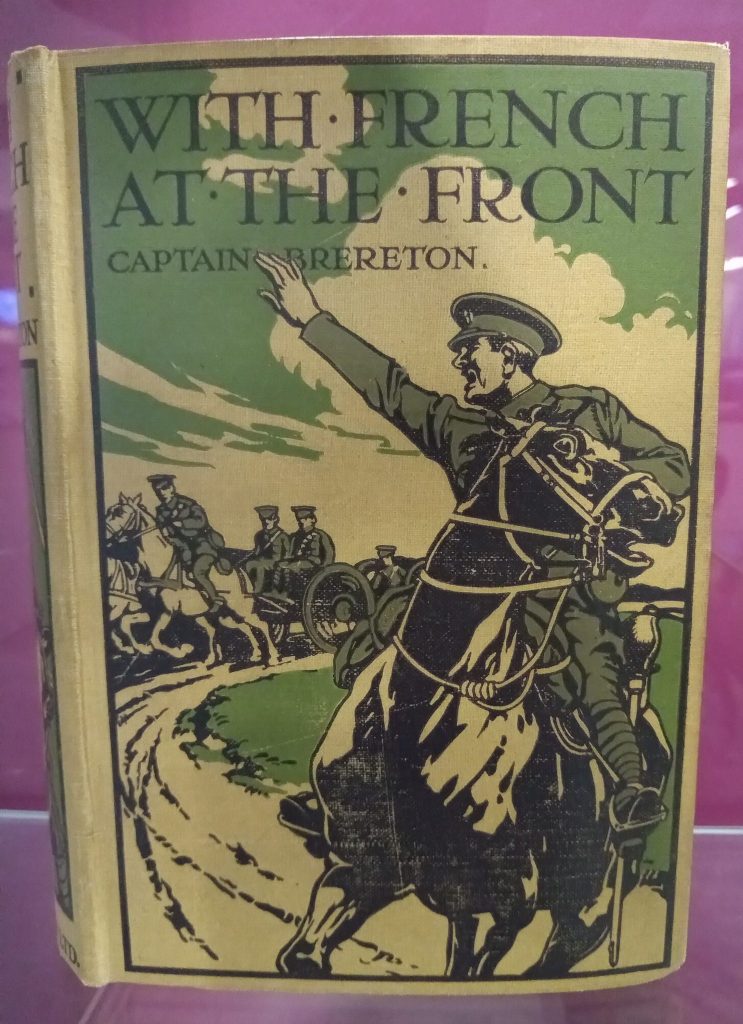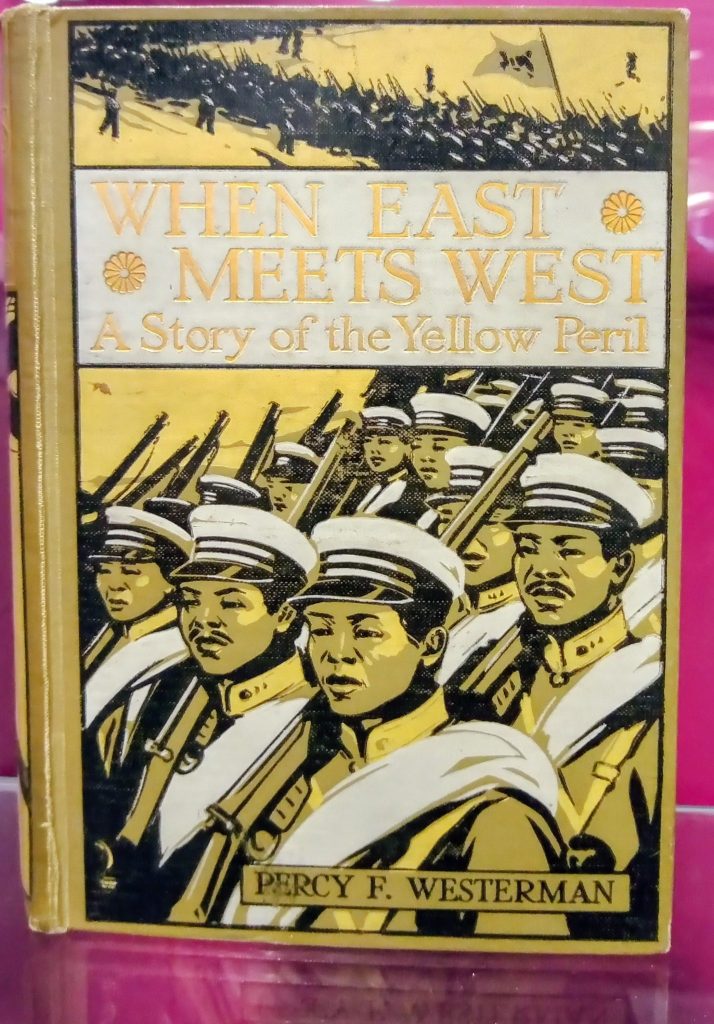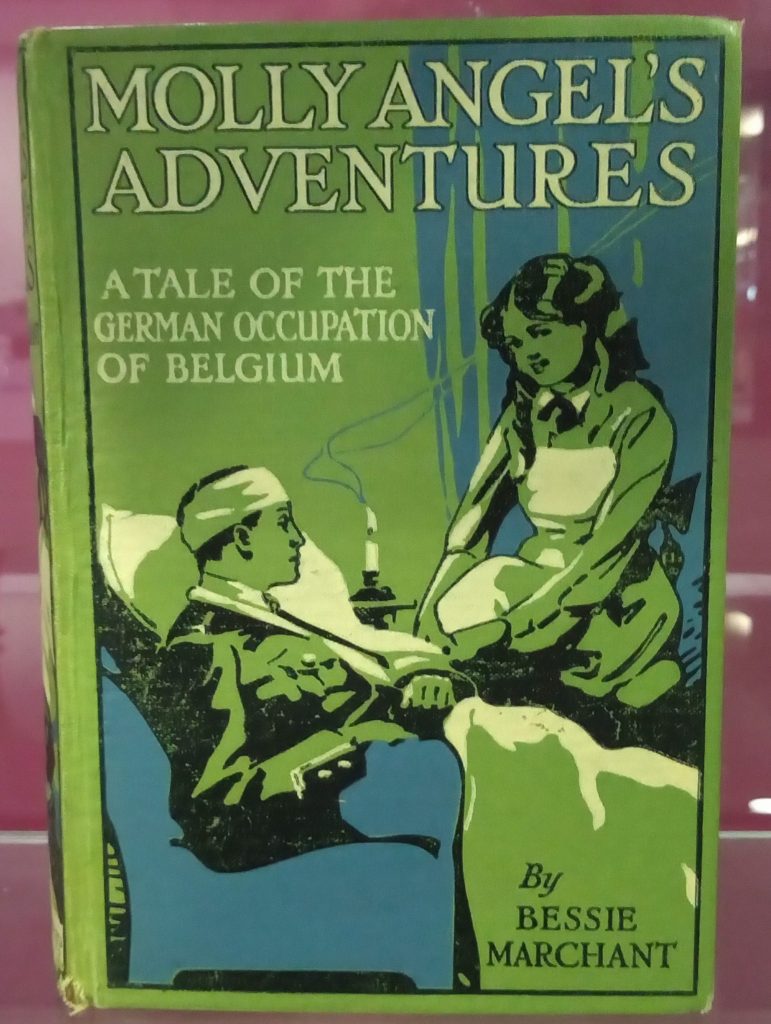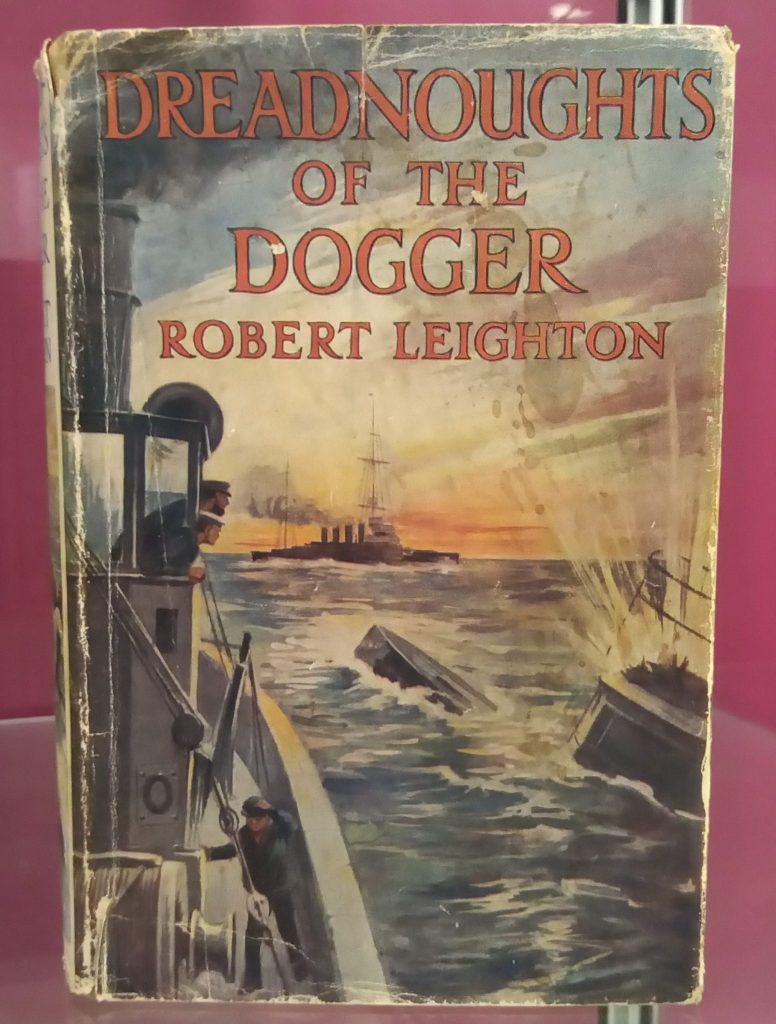Today the MA Modern History students came to visit the library to see the Historical Children’s Fiction collection to find out what children’s literature can contribute to their study of Activism, Propaganda and Popular Culture.
The visit began with a talk from Dr Dave Budgen on children’s literature in the years leading up to the First World War in which Dave discussed his research into the novels of Herbert Strang, Percy F. Westerman, Captain Brereton and Bessie Marchant, and outlined the popularity of adventure and later war stories at this period. Fiction had an important role to play in shaping and reflecting understandings of conflict and heroism in the minds of its young readers and children were “frequently seen as an important target for propaganda” (Budgen, 2018, 3) with books given as Christmas gifts or prizes for school attendance.
The students were then invited to explore a selection of books from the collection and asked to consider how they might use these in a research project. Here are some of titles and authors they looked at:
The Blue Book for Boys (1912) by Herbert Strang
Herbert Strang was the pseudonym of George Herbert Ely (1866–1958) and Charles James L’Estrange (1867–1947). The duo specialized in writing adventure stories for boys, including several anthologies such as the Blue Book for Boys. They also used the pseudonym “Mrs Herbert Strang”, for adventure books for girls, notably The Girl Crusoes. The pair are classified as “popular writers of imperial fiction” and “successors of G. A. Henty” (Kitzan, 2001). The Blue Book for Boys contains short stories about the heroic past and Empire, as well as stories set in public schools, reflecting the middle-class background of its authors. Written from a White British point of view where the white man always triumphs, the book does contain some racist content. It was illustrated by T.H.R. (Thomas Heath Robinson) and Cyrus Cuneo.
Round the World in Seven Days (1910) by Herbert Strang
Round the World in Seven Days was one of Strang’s most popular books, celebrating the possibilities that aviation brought to travel and adventure, and was influenced by Jules Verne’s 1872 novel Around the World in Eighty Days. The story centres on Lieutenant Charles Thesiger Smith, a daring aviator who learns that his father, a renowned geologist, is stranded on Ysabel island in the Solomon Sea after a shipwreck. Determined to rescue him, Charles embarks on a high-stakes journey around the world in his aeroplane, attempting to complete the mission in just seven days. The story contains themes of natural disasters, mechanical failures, encounters with hostile locals, espionage and sabotage, and reflects the early 20th-century fascination with aviation and global connectivity.
With French at the Front: A Story of the Great European War down to the Battle of Aisne (1915) by Captain Frederick Sadleir Brereton
Captain Brereton (1872-1957) was a British Army medical officer and author of children’s books. He served in the Royal Army Medical Corps during the Boer War and First World War. His stories focussed on heroic deeds and Empire (Paris, 2004). He published at least 9 books during the first world war about the heroism of the British armed forces. With French at the Front is the story of Captain James Fletcher and reflects Brereton’s own experiences as a soldier, describing the daily life of troops, their living conditions, and the horrors of trench warfare. The story is illustrated by Archibald Webb (1866-1947) who also illustrated works by George Alfred Henty.
When East Meets West: A Story of the Yellow Peril (1913) by Percy F. Westerman
Percy F. Westerman (1876-1959) was an author of adventure stories with military and naval themes. During the First World War, he was employed on coastal duties by the Royal Navy, and later as an instructor of navigation for the Royal Flying Corps. When East Meets West reflects early 20th-century Western anxieties about the rise of Asian powers, particularly in China and Japan. The novel contains themes of naval and land battles, espionage, technological warfare and cultural clashes. It was Illustrated by Charles Murray Padday, who used a monochromatic palette creating a photorealistic effect.
Molly Angel’s Adventures: A Tale of the German Occupation of Belgium (1915) by Bessie Marchant
Bessie Marchant (1862-1941), author of girls’ adventure novels. was born in Petham, near Canterbury. Known as the “the girls’ Henty”, (a reference to G.A. Henty, the author of popular adventure stories for boys), she wrote stories set in countries across the globe. Molly Angel’s Adventures is a World War I adventure novel which blends historical fiction with themes of courage, patriotism, and female agency. Molly is a British girl caught in occupied Belgium who must navigate the dangers of war, including helping wounded soldiers, evading German patrols and supporting resistance efforts. The novel is illustrated by P.B. Hickling, who also illustrated Ladybird books.
Dreadnoughts of the Dogger (1916) by Robert Leighton
Robert Leighton (1858-1934) was a Scottish journalist and writer of boys’ fiction. Dreadnoughts of the Dogger is an historical adventure novel set during World War I, focusing on the naval conflict between Britain and Germany in the North Sea, particularly around the Dogger Bank. The story follows Mark Redisham, a young Sea Scout, and his brother Rodney, a midshipman in the Royal Navy. After war is declared, the boys are drawn into the unfolding drama of naval warfare, espionage, and patriotism. Themes of identity, nationalism, and moral choice are explored through the character of Max Hilliger, a German boy living in Britain, whose divided loyalties create personal and political conflict as the war intensifies. The novel emphasizes the courage and idealism of young people caught up in war and reflects contemporaneous concerns around the importance of naval supremacy and the threat posed by German U-boats.
After exploring the books, the students had a demonstration of Gale Primary Sources in which they could identify newspaper reviews of the novels from the period. These were then juxtaposed against more recent critique, to evidence changing views of the novels and their themes.
You can read more about the representation of the outbreak of war, the Western Front, and other theatres of conflict, in Dave’s book British Children’s Literature and the First World War Representations since 1914.
You can find out more about the Historical Children’s Fiction Collection on the library website or visit our display of early twentieth century children’s fiction on the ground floor of Augustine House.
 Library
Library Michelle Crowther
Michelle Crowther 179
179